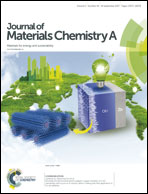Enhancing perovskite solar cell performance and stability by doping barium in methylammonium lead halide†
Abstract
Organic–inorganic lead halide perovskite solar cells are considered as one of the most promising technologies for future photovoltaics because they show high power conversion efficiency (PCE) and can be fabricated through a simple solution process. Non-toxic alkaline-earth metal cations are suitable candidates to replace toxic lead in perovskite because they maintain the charge balance in perovskite and some of them meet the tolerance factor of Goldschmidt's rule. We investigated four kinds of alkaline-earth metal cations (Mg2+, Ca2+, Sr2+, and Ba2+) to replace lead cations partially. Among these four alkaline-earth metals, the Ba2+ is most suitable for Pb2+ replacement in perovskite films and exhibits the best power conversion efficiency. Furthermore, we systematically studied the crystal structure, absorption behavior and surface morphology of Ba2+-doped perovskite films with different doping levels. The relationship between the charge carrier dynamics and Ba2+ concentration was evaluated by the time-resolved photoluminescence (TRPL) technique. The Ba2+-doped perovskite films that can be processed in the environment containing moisture (1.0% relative humidity) are stable. At the optimal 3.0 mol% Ba2+ replacement, the PCE of the fabricated solar cell is increased from 11.8 to 14.0%, and the PCE of champion devices is as high as 14.9% with increased storage stability.



 Please wait while we load your content...
Please wait while we load your content...